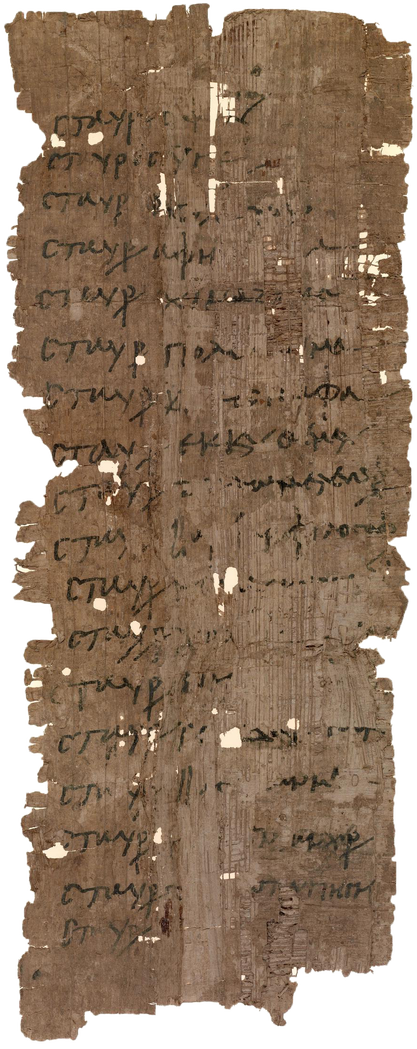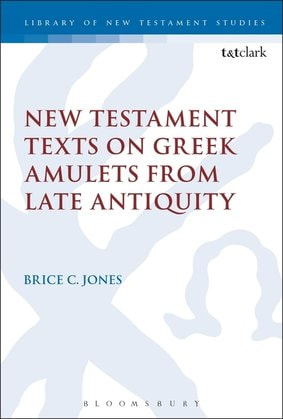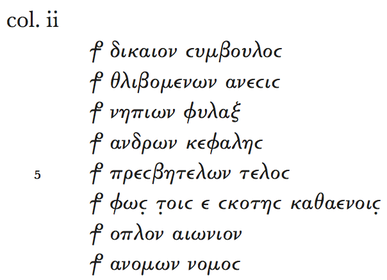|
In the latest volume of the Oxyrhynchus Papyri series, Brent Landau and T.C. Hoklotubbe provide the edition of a fifth/sixth century papyrus (P.Oxy. 81.5260), which preserves a variant of a Christian hymn known from several Greek patristic sources. The title to their entry is, “Hymn of the Cross: Amulet?” Each line of the fragment begins with a standalone staurogram (the combination of the Greek letters tau and rho) representing the word “cross” (this is highly unusual), followed by a descriptive phrase. Here is an example from column 2:  P.Mich. inv. 1628 P.Mich. inv. 1628 I here want to draw attention to the fact that a variant of this “cross hymn” is found in another, earlier Greek papyrus fragment housed at Michigan. The papyrus, P.Mich. inv. 1628 (LDAB 195), was published in 1984 by Nancy Priest, who drew parallels with the text of Alexander Monachus’ De inventione sanctae crucis (see PG 87:4073). Neither the Michigan papyrus nor the text of Alexander are mentioned by the authors of the new Oxyrhynchus fragment, so a couple noteworthy observations can be made. In the Michigan fragment, the word “cross” (σταυρός) begins each line and is abbreviated all but two times as σταυρ, with an oblique stroke written through the letter rho (see image at right). It just so happens that this stroke combined with the letter rho resembles a staurogram, which stands alone at the beginning of each line in the Oxyrhynchus fragment. One might be tempted to argue that the scribe created the staurogram in this way intentionally, although this oblique stroke is a typical marker of abbreviation (in fact, he/she uses it as such in l. 16 for another word. So, we cannot be too sure. More importantly, the Michigan papyrus has textual parallels with the sources cited by Landau and Hoklotubbe: Pseudo-Chrysostom (which, as the authors show, has been attributed to John II, bishop of Jerusalem), Ephrem the Syrian, and John of Damascus. For example, the Michigan fragment shares a few readings with all three patristic sources: σταυρὸς χειμαζομένων [Ps.C: -οντων] λιμήν; σταυρὸς ἐκκλησίας θεμέλιος, σταυρὸς δούλων ἐλευθερία. Other readings in the Michigan fragment are shared with only one or two of the patristic sources but it is clear that all these sources are drawing on a common literary tradition. These parallels are important for two reasons: dating the composition of the hymn and reconstructing the text of the Michigan fragment. The Michigan papyrus was dated to the fourth century ("or perhaps a bit later"); the Oxyrhynchus papyrus was dated to the fifth/sixth century. Landau and Hoklotubbe say, “Although 5260 is dated to the fifth/sixth century, the hymn may have originated earlier, at a time when the composition of new hymns was controversial” (p. 12). Given the dating of the Michigan papyrus, we can at least say that variants of the hymn were indeed circulating around a century prior to the composition of the Oxyrhynchus fragment. As Landau and Hoklotubbe demonstrate, the stanzas of this hymn diverge among all sources, both in content and sequence. The hymn probably has earlier origins and was perhaps reshaped by different authors in different locations along the way for various purposes (this was typical of homiletical texts, for example). Priest did not reference the sources cited by Landau and Hoklotubbe but those sources are incredibly significant because now some lines in the Michigan fragment can be restored with certainty. I am working on a re-edition of P.Mich. inv. 1628 and will try to submit that for publication soon. Finally, it is interesting to note that Priest, Landau, and Hoklotubbe all wonder about the function of their papyri. Priest argued that the Michigan fragment may have served as a hand-list of notes for a sermon on the cross. Landau and Hoklotubbe suggest the Oxyrhynchus fragment could have been designed as an amulet or for liturgical use. It is difficult to say with certainty how these papyri functioned (prayer? homily? amulet? notes? private devotion?) but the question is worth pondering. These papyri, especially the Oxyrhynchus fragment, also raise some interesting questions about the development/use of the staurogram in early Christian artifacts.
2 Comments
Frank Ramirez
5/19/2017 12:09:15 am
Fascinating. Read the entry of 5260 in the Oxyrhynchus Papyri, and thought of the Hurtado article right away. It may well come from much earlier than the fifth-sixth century, considering the possibility of the nomina sacra being something of a graphic depiction of the cross centuries before there were artistic representations of the cross. I look forward to your future work on this.
Reply
James Snapp Jr
link
10/14/2017 03:04:07 pm
The suspense is building. Is further publication imminent?
Reply
Your comment will be posted after it is approved.
Leave a Reply. |

Available at Amazon!
Archives
June 2020
Categories
All
|
